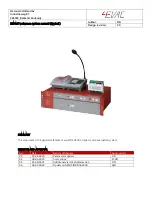
126 | ni.com | NI DIDS-2100 Series User Manual
AutoClearFlagWhileCranking
Tip Strip: Auto-clears EPT errors during
=
CRANKING
Detail: Sometimes, as the engine stops, the crankshaft may spin in a way that causes an erroneous loss of
sync as the crankshaft comes to a rest and a fault flag will be set. This can often be prevented by increasing
the
value. However, if an EPT fault flag is set when the engine stops, the DI Driver System
can optionally automatically clear any EPT fault flags during the next cranking of the engine for starting.
When this button is
ON
, then EPT error flags will be automatically cleared while
indicates
CRANKING
.
CamOffsetEnable
Tip Strip: Enables the cam signal to be offset by a specified number of crank pulses
Detail: The DI Driver System provides an optional offset function applied to the cam signal selected by
. The offset function offsets the cam signal by the number of crank teeth specified by
.
The starting reference for the offset is the rising edge of the cam signal input to the function. The resulting
offset cam signal will have a width equal to one crank tooth period. The offset cam signal will go high at
the falling edge of the crankshaft signal immediately following the specified
edges of the crank signal. The offset cam signal will go low at the following rising edge of the crank signal.
The resulting signal may need to be extended. The input to the cam offset function is from the digital input
assigned to the Cam1 or Cam2 signal via the
window. The output of the cam offset
function is delivered to the cam extension function. When
Enabled
, the cam signal is offset. When
Disabled
,
the camshaft signal is unaltered. The offset and the extended cam signals may be monitored in the
CamOffset
Tip Strip: Specifies the number of crank pulses to offset the cam pulse
Units: pulses
Detail: The DI Driver System provides an optional offset function applied to the cam signal selected by
. The offset function offsets the cam signal by the number of crank teeth specified by
.
The starting reference for the offset is the rising edge of the cam signal input to the function. The resulting
offset cam signal will have a width equal to one crank tooth period. The offset cam signal will go high at
the falling edge of the crankshaft signal immediately following the specified
edges of the crank signal. The offset cam signal will go low at the following rising edge of the crank signal.
The resulting signal may need to be extended. The input to the cam offset function is from the digital input
assigned to the Cam1 or Cam2 signal via the
window. The output of the
function is delivered to the
function. The offset and the extended cam signals may be
tab.
Summary of Contents for NI DIDS-2103
Page 11: ...NI DIDS 2100 Series User Manual National Instruments 11 3 2 Software...
Page 32: ...32 ni com NI DIDS 2100 Series User Manual...
Page 40: ...40 ni com NI DIDS 2100 Series User Manual 3 3 Hardware...
Page 44: ...44 ni com NI DIDS 2100 Series User Manual 3 3 3 Connecting Injectors Sensors and Actuators...
Page 174: ...174 ni com NI DIDS 2100 Series User Manual Aux PWX 2 4 See above descriptions...
Page 210: ...210 ni com NI DIDS 2100 Series User Manual 12 Connecting Port Fuel Injectors to the PFI Driver...
Page 214: ...214 ni com NI DIDS 2100 Series User Manual 16 9066 RS 232 Serial Connector to TDK Power Supply...
Page 216: ...216 ni com NI DIDS 2100 Series User Manual 8 Important Information...
Page 223: ...NI DIDS 2100 Series User Manual National Instruments 223...
















































